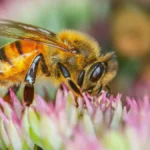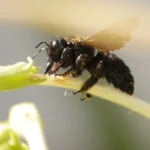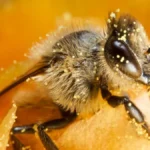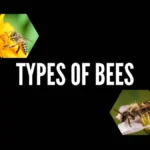How do bees get pollen from flowers? We will take a look at pollen gathering in bees and how these amazing creatures collect, store and ferment pollen to make food for the hive.
Why Do Bees Collect Pollen?
If we look at social wasps such as yellow jackets, they forage on nectar for energy and meat and insects for protein. Bees made the transition to a plant-based diet at some point long in the past when the ancestor of modern bees began using pollen instead of animal protein.
Pollen is collected and taken back to the hive, where it is either stored or turned into food for the bees to eat. Pollen is nutritious and contains proteins, carbohydrates, vitamins, fats, minerals, and phytomedicinal compounds, amongst other things.
How Do Bees Get Pollen From Flowers?
A forager bee is quite a fluffy creature when it is young. The thorax and a little of the head are covered in hairs that are branched or plumose. As the bee rummages around in flowers, it becomes covered in pollen that sticks to these plumose hairs.
The bees comb the hairs using their front legs and remove the pollen. This is then packed into the corbiculae, a special hairy region on the hind leg. A corbicula is also known as a pollen basket. This system is highly efficient, and bees can carry up to, or slightly over half their body mass in pollen.
There is considerable variation in the nutritional quality of pollen given that there is incredible biodiversity in the flowering plants. Bees will collect pollen from both nectar-bearing and even wind-pollinated plants. In times of pollen shortage, some bees have been observed collecting spores from mushrooms, or even collecting protein supplements from feedlots. I have seen bees collect soya flour in such situations.
Where Else Can Bees Collect Pollen?
Bees are intelligent animals and adapt to circumstances. I remember once watching carpenter bees foraging on Keurboom trees. This tree is a beautiful leguminous species, and carpenter bees are able to force the flowers open and access the pollen. Honey bees struggle to do this as they are smaller.
The carpenter bees would work around the flower until they were covered in pollen, and then the honeybees would jump on the back of the carpenter bee. This triggered the carpenter bee to just hover in the air as though a drone bee was mating with it. The honey bee would then comb the pollen off the carpenter bee, pack its pollen baskets and fly away to its hive. The carpenter bee then went about its business visiting more flowers. By the time it was covered in pollen, the bee was back to rob it again.
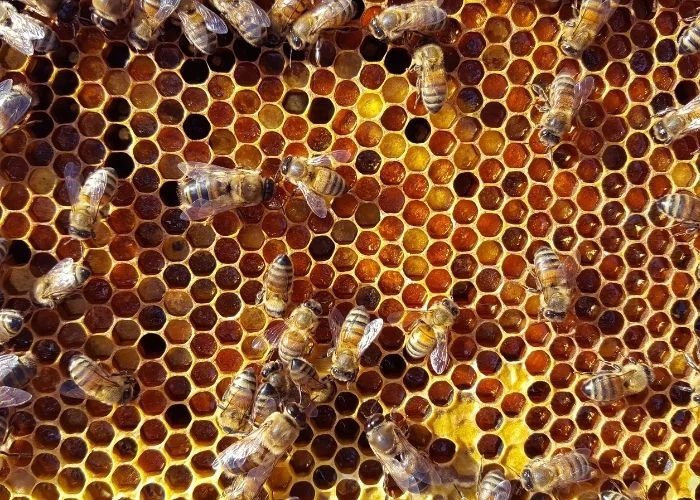
The Important By-product Of Bees Collecting Pollen
We are all here because bees collect pollen. When bees collect pollen, they move it around on the flowers and can either pollinate or cross-pollinate flowers depending on what is required. Many bee pollen flowers, such as canola, many fruits, sunflowers, berries, nuts, bulbs, vegetables, require bees to visit them to set seed or fruit. Without these complex human foods, we would not be able to have the brains we have.
Honeybees are scalable bees. This means we can bring large quantities of bees into an area and pollinate dense plantings of crops. Wild populations of bees would be insufficient to achieve this task. An example is the almond crop in California, where about 1.6 million beehives are brought into the area to pollinate this crop. This is a similar story for apple, cherry, and other fruit orchards where beehives are brought in for pollination.
So the byproduct of bees pollinating crops, my dear reader, is you. A significant percentage of the nutrients in your body are derived from plants pollinated by bees. And most of these are the tastiest things you eat. The chances are the chemicals in your eyes that allow you to see this screen and the neurotransmitters in your brain were largely derived from bee-pollinated foods you ate.
Where Do Bees Store Pollen?
When a bee returns from the field with a heavy pollen load, she will do one of two things. This will depend on the beehive’s pollen nutrition status.
A Beehive That Needs As Much Pollen As Possible
If the hive is actively using pollen, she will take this pollen to the active pollen processing sites which are adjacent to the brood nest. Here the pollen is mixed with some nectar and packed into the cells.
The pollen in the cells undergoes a fermentation at the hands of an interesting array of microbes. This process turns pollen into bee bread – a digestible version of pollen. The activity of lactic acid bacteria introduced to the pollen from the bee’s nectar regurgitation enables the pollen to be increased in nutritional value.
Nurse bees are fed this bee bread and use it to produce royal jelly, a basic starting food for all bee larvae. Pollen is also fed to all bees, bar the queen, at a later stage.
A Beehive That Has More Pollen Than Is Needed
When a hive is able to collect more pollen than it requires, it can decide to store this pollen. Bees store pollen slightly differently than when they make bee bread. Pollen stores are stored in a dry sense and are not fermented.
In an exceptional honey flow, the bees can cover pollen stores with honey and then cap the honey. This gives you interesting, nutritious comb honey that has both pollen and honey. Some people find this disturbing, but eating such a comb is one of my favorite things. There are many health benefits associated with eating pollen.
A Note On Pollen Stores
The majority of the bees kept in North America are not adapted to deal with the small hive beetle, Aethina tumida. These beetles can lay eggs in pollen stores, and this can lead to outbreaks of beetles. If your bees store copious pollen, it is advisable to have a very aggressive beetle control program using environmentally friendly traps.
Read more about Small Hive Beetle Treatment
I hope this article has helped you understand how bees get pollen from flowers. The bees are incredible creatures, and we can learn a lot from their processing of pollen into bee bread. This is similar to Lacto-fermented human food and ensures great gut health. If you enjoyed this article, please share it widely.

Dr. Garth A. Cambray is a Canadian/South African entrepreneur and beekeeper with 28 years of experience in apiculture and specializes in adding value to honey. His Ph.D. research developed a new advanced continuous fermentation method for making mead that has resulted in a number of companies globally being able to access markets for mead. His company, Makana Meadery, exports honey mead to the USA where it is available to discerning connoisseurs. He has also developed technologies to commercially manufacture organic honey vinegar in Zambia for export globally. He holds a few patents globally in the ethanol industry and believes in technology and knowledge transfer for human development and environmental sustainability. One of his proudest achievements is the fact that the wind farm he started at one of his old apiary sites has essentially made his hometown carbon neutral.

